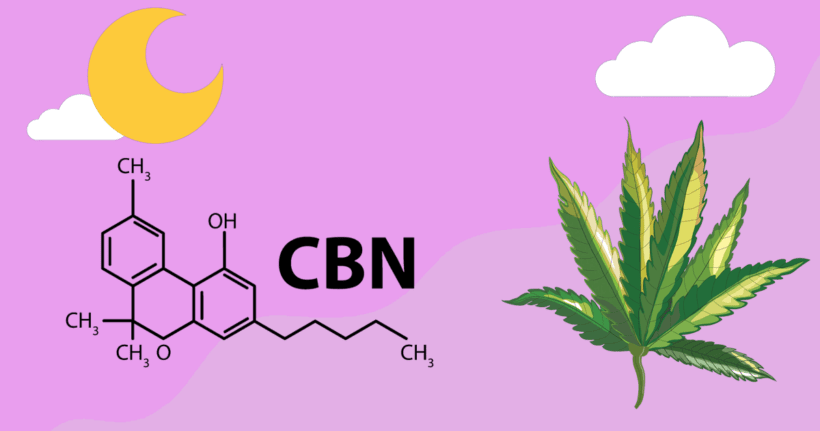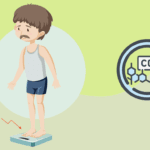Cannabinol (CBN) is a non-intoxicating compound present in cannabis. It’s considered a minor cannabinoid because its levels in cannabis are usually low.
Unlike most cannabinoids, which are made directly by the cannabis plant, CBN is a byproduct of THC degradation.
More specifically, when cannabis is harvested and exposed to heat and light, the THC gradually breaks down into CBN (1). As a result, old cannabis buds have lower THC and higher CBN concentrations.
Recently, CBN has gone from relative obscurity to a popular option alongside CBD. Most of that has to do with its proposed sleep benefits.
Table of Contents
How Does CBN Differ from CBD?
| CBN | CBD | |
| Intoxicating? | No | No |
| Main potential Benefits | Sleep aid, pain relief, neuroprotection, appetite stimulant, anti-inflammatory | Anti-inflammatory, sleep aid, pain relief, neuroprotection, appetite suppressant, anti-seizure, anti-anxiety, anti-nausea antipsychotic |
| How it works | CB2 receptor, TRP channels | FAAH endocannabinoid enzyme, serotonin receptor, TRP channels, and more |
The similarities between CBD and CBN include:
- Both are non-intoxicating, so they won’t get you high.
- CBD and CBN share some properties, like anti-inflammatory and pain-relieving effects
- Both are widely used to support healthy sleep, usually in combination
They also differ in some ways:
- CBN is found in much smaller quantities than CBD
- CBN seems to increase appetite, whereas CBD appears to reduce it
- CBN works differently from CBD
Did you know? CBN was the first cannabinoid to be isolated from cannabis in 1896. Thanks to its remarkable stability, CBN is also used to identify ancient cannabis samples (1).
CBN Effects & Benefits
Research suggests that CBN has a variety of potential health benefits:
- Sleep. A 2023 clinical study found that 20 mg of CBN improved sleep and reduced sleeping disturbances and awakenings, unlike placebo (2)
- Anti-inflammatory. In a 2013 mouse study, CBN reduced inflammatory molecules, helping reduce airway allergy (3)
- Pain relief. CBN improved muscle pain in a 2019 rat study (4)
- Neuroprotection. A 2005 mice study found that CBN may protect neurons from damage and delay the onset of amyotrophic lateral sclerosis (ALS) (5), while in a 2011 study, CBN protected mitochondria from age-related neurodegeneration, suggesting benefits for Alzheimer’s, Parkinson’s, and Huntington’s disease (6)
- Appetite stimulation. A 2012 study found that CBN stimulated appetite in rats (7)
- Anti-glaucoma. A 2022 study in isolated cells and rats found that CBN may protect against glaucoma (8)
- Antibacterial. CBN showed antibacterial properties in a 2008 study (9)
- Epidermolysis bullosa. Ongoing research suggests that CBN may help with a rare skin condition called epidermolysis bullosa, which causes easy skin blistering (1)
- ADHD. A 2020 Israeli study found that cannabis strains high in CBN were associated with improved ADHD symptoms in 59 adults (10).
All in all, the available research suggests that CBN has many potential benefits, some similar to CBD, while others distinct. However, further research is needed to confirm these findings and fully understand CBN’s therapeutic potential.
CBN & Sleep: More Evidence Needed
There’s a widespread belief that CBN may help manage sleep-related problems like insomnia. It’s based on the observation that cannabis that’s been left to sit around too long and is rich in CBN has more potent sleep-inducing effects.
However, according to trusted cannabis researcher Dr. Ethan Russo, this may be because old marijuana is rich in oxygenated terpenes, which have more sedating effects.
Still, early studies show that CBN may indeed have sleep-promoting effects. One 2023 randomized controlled trial (the gold standard of human research) tested the effects of CBN in 293 people with poor sleep.
Unlike the placebo, a 20 mg dose of CBN enhanced sleep quality, sleep disturbances, and nighttime awakenings (2). Interestingly, the addition of varying amounts of CBD (10-100 mg) didn’t enhance CBN’s effects. This is the first real, high-quality evidence that CBN may indeed be helpful for sleep.
Still, one study isn’t enough to say that CBN works for certain. Further research is needed.
How Does CBN Work?
We don’t yet fully understand how CBN works. But like all cannabinoids, it seems to interact with the body’s endocannabinoid system (ECS).
In particular, research suggests that CBN has a stronger attraction to CB2 receptors, which are common in immune system tissues, rather than CB1 receptors (for which THC has a strong affinity) (1).
CBN may also interact with TRP channels, which are involved in pain and inflammation.
Safety & Side Effects
CBN appears to be as safe as CBD. Although there isn’t much research on the safety of CBN, a high-quality 2023 study didn’t report any significant side effects (2).
Still, we recommend consulting your doctor before trying CBN if you’re taking any prescription medications. There is a possibility of drug interactions.
CBN Dosage
There isn’t enough evidence to suggest a CBN dosage. Besides, it varies based on your body weight, genetics, the type of product you’re using, and other factors.
The ideal approach is to start with a small amount and slowly work your way up until you start to feel the desired effects (11). You can also use your product’s suggested dosage as a starting point.
I used this method to find the right CBD and CBN dosage for myself.
My Experience With CBN
I’ve tested over a dozen CBN products, including oils, gummies, and capsules.
They were more effective at improving my sleep than regular CBD formulas. I generally fell asleep faster, woke up fewer times at night, and felt more rested. I also felt the calm and relaxation that’s common with CBD.
Still, it’s important to note that most CBN products on the market are full-spectrum formulas with more CBD than CBN. So, CBD also contributes to the sleep benefits.

Shopping for & Using CBN Products
CBN is sold in the same variety of products as CBD, including oils, capsules, gummies, topicals, and vapes. In most cases, the CBN is combined with a larger dose of CBD, but it depends.
Generally, you’ll come across three types of CBN formulas:
- Pure CBN isolate without any other cannabinoids
- Pure cannabinol isolate combined with pure CBD
- A full-spectrum CBD formula containing the full range of hemp cannabinoids and terpenes, plus added CBN
I recommend going for full-spectrum CBN oil as your go-to product. Full-spectrum formulas are more effective than isolated cannabinoids, and oils are generally the best way to administer CBN, thanks to efficient absorption, long-lasting effects, and easy dosage control.
Whatever product you choose, if you’re using CBN for sleep, take it about 30-60 minutes before bed to give it time to kick in.
Sources
- Maioli, Chiara, et al. “Cannabinol: History, Syntheses, and Biological Profile of the Greatest “Minor” Cannabinoid.” Plants 11.21 (2022): 2896.
- Bonn-Miller, Marcel O., et al. “A double-blind, randomized, placebo-controlled study of the safety and effects of CBN with and without CBD on sleep quality.” Experimental and Clinical Psychopharmacology (2023).
- Jan, Tong-Rong, et al. “Attenuation of the ovalbumin-induced allergic airway response by cannabinoid treatment in A/J mice☆.” Toxicology and applied pharmacology 188.1 (2003): 24-35.
- Wong, Hayes, and Brian E. Cairns. “Cannabidiol, cannabinol and their combinations act as peripheral analgesics in a rat model of myofascial pain.” Archives of oral biology 104 (2019): 33-39.
- Weydt, Patrick, et al. “Cannabinol delays symptom onset in SOD1 (G93A) transgenic mice without affecting survival.” Amyotrophic Lateral Sclerosis 6.3 (2005): 182-184.
- Liang, Zhibin, et al. “Cannabinol inhibits oxytosis/ferroptosis by directly targeting mitochondria independently of cannabinoid receptors.” Free Radical Biology and Medicine 180 (2022): 33-51.
- Farrimond, Jonathan A., Benjamin J. Whalley, and Claire M. Williams. “Cannabinol and cannabidiol exert opposing effects on rat feeding patterns.” Psychopharmacology 223 (2012): 117-129.
- Somvanshi, Rishi K., et al. “Cannabinol modulates neuroprotection and intraocular pressure: A potential multi-target therapeutic intervention for glaucoma.” Biochimica et Biophysica Acta (BBA)-Molecular Basis of Disease 1868.3 (2022): 166325.
- Appendino, Giovanni, et al. “Antibacterial cannabinoids from Cannabis sativa: a structure− activity study.” Journal of natural products 71.8 (2008): 1427-1430.
- Hergenrather, Jeffrey Y., et al. “Cannabinoid and terpenoid doses are associated with adult ADHD status of medical cannabis patients.” Rambam Maimonides Medical Journal 11.1 (2020).
- Lucas, Catherine J., Peter Galettis, and Jennifer Schneider. “The pharmacokinetics and the pharmacodynamics of cannabinoids.” British journal of clinical pharmacology 84.11 (2018): 2477-2482.

Gleb is a freelance writer from Vancouver, Canada specializing in CBD and cannabis. He’s read thousands of studies on CBD and other supplements, helping him translate complex science into plain language. Gleb has tried and reviewed dozens of CBD brands and products, written third-party testing reports, and knows the CBD industry inside and out. When not writing, he likes to kickbox, travel, and tell everyone how awesome intermittent fasting is.




